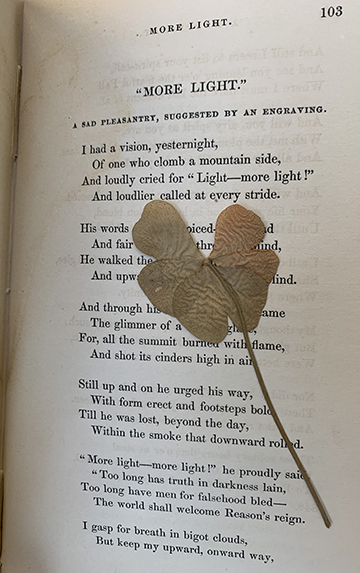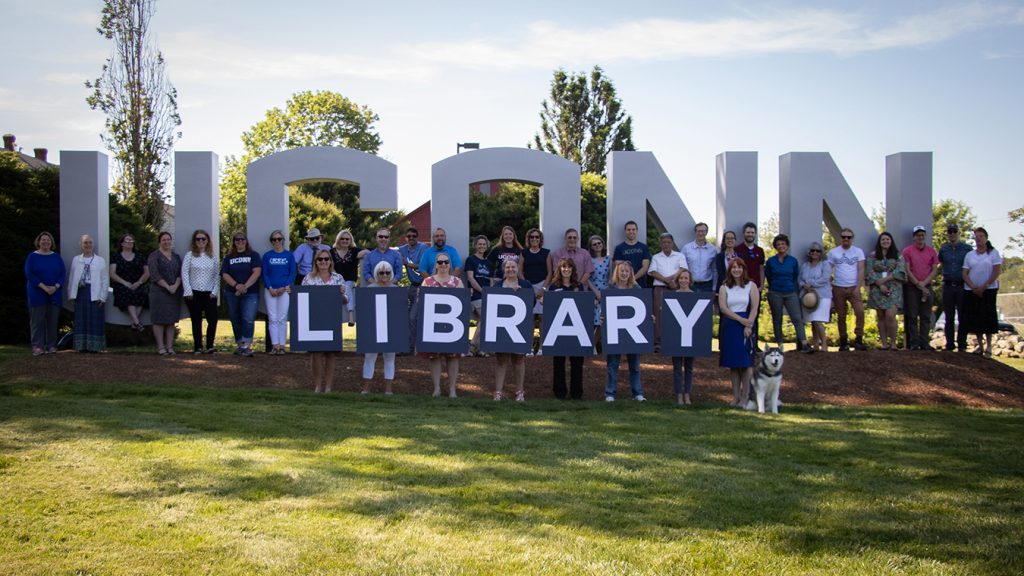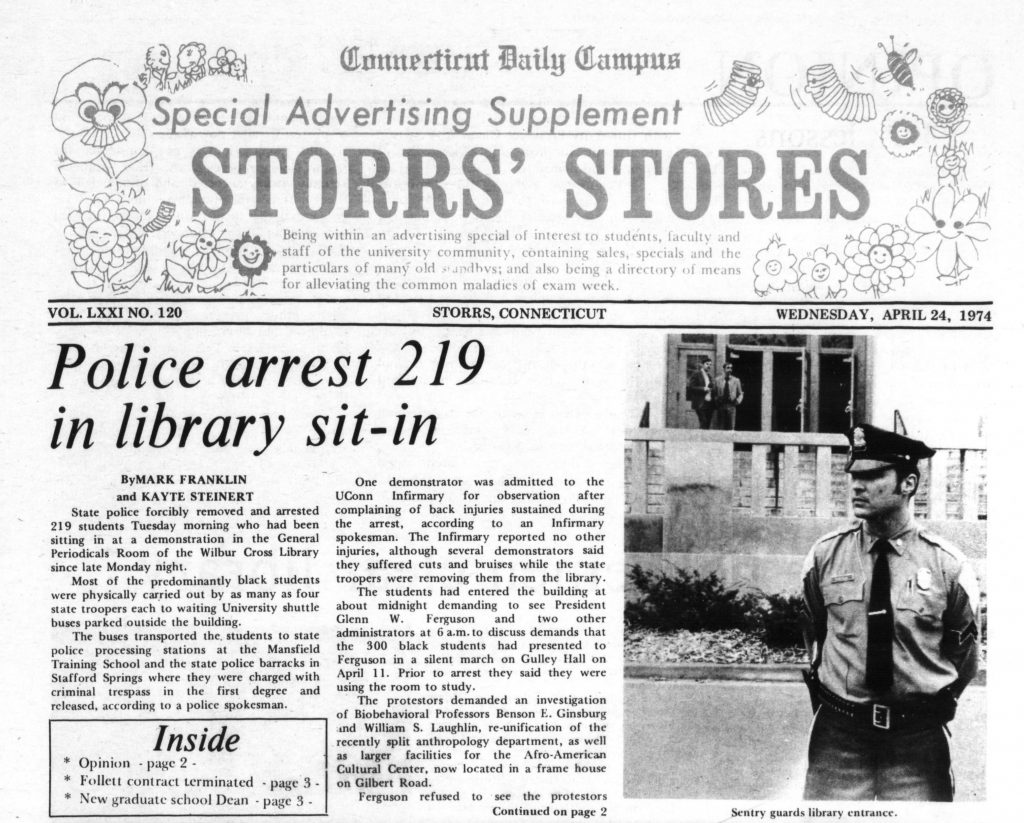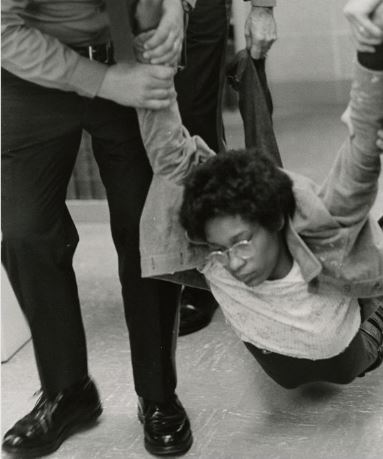Post written by Michael Rodriguez, Collections Strategist

Book Traces is a national project led by the University of Virginia to discover and document handwritten inscriptions, marginalia, and other readerly markings in old library books. Last year we were interested in knowing if our older collections in the stacks contained interesting marginalia and we discovered some remarkable stories about the books, their readers/owners, and the library that holds them.
We randomly selected 2,000 UConn Library books published before 1925. We wanted books only with historical annotations – no highlighting or fresh marks! Once our student employee Vanessa Garcia located the book on the shelf, she paged through it and snapped photos of any noteworthy markings using a library-supplied iPad. All the photos were uploaded to booktraces.org, which features crowdsourced images of over 3,100 marked-up old library books.
What did we find?
Some 12% of the 2,000 books in our sample contained markings. Approximately 1.5% revealed what University of Virginia scholars call “notable interventions.” Supplemented by genealogical research, these markings give real insight into past readers and owners and enables us to trace the genealogy of library books. Like many universities, UConn Library’s early collections were built largely through gifts of previously owned books. Thus, our findings also give insight into UConn’s history and the growth of UConn’s library.

Glued-in Letter from 1846
UConn’s copy of Chronicle of Calais in the Reigns of Henry VII and Henry VIII was a gift—a peace offering—from prominent English printer John Gough Nichols in 1846. “I have always regretted your secession from the Camden Society,” wrote Nichols, “until now that it gives me the excuse for requesting your acceptance of a copy of the book I have just edited.” Nichols’ letter is glued onto the book’s flyleaf. The unknown addressee must have quit the Camden Society, founded by Nichols in 1838, after a dispute. He or his heirs presumably regifted Nichols’ book to UConn.
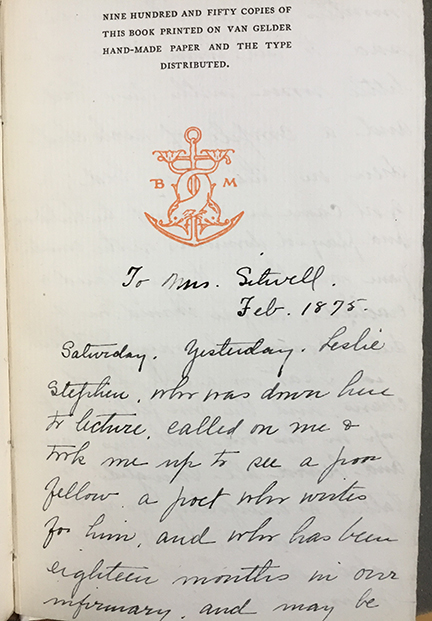
Reader Engagement with Poetry
In Hospital, a collection of poems by William Ernest Henley published in 1908, includes a poem called “Children: Private Ward,” on whose page is the annotation “see page 41, R. L. S.” On page 41, the owner of the book had copied in longhand a published letter by Robert Louis Stevenson, author of Treasure Island. Like Henley’s poem, Stevenson’s letter alludes to children in sickbed. The book’s owner evidently felt it was very important to read poem and letter together. He or she may have felt a deep personal connection to the theme of children suffering from illness.
Notes of a Solo Woman Traveler

Italien Handbuch für Reisende is a Baedeker’s German-language travel guide to Italy. Published in 1902, it is filled with miniscule, penciled English reading notes on Italian art and geography. The flyleaf shows an ownership inscription in the name of Ida Prescott Clough, with an address of Friedrichstraße 124 in Berlin, Germany, and a sketch captioned “Shape of Doge’s cap.” This refers to the distinctive hat worn as a mark of office by the Venetian doge, or leader.
Research reveals that the book’s owner, Ida Prescott Clough (1875–1959) was a Bostonian and Radcliffe College alumna. In 1902, she lived and traveled in Europe, where she likely acquired this German guidebook, in which she jotted countless observations and sketches. Miss Clough journeyed solo in an era when society frowned on young women traveling unaccompanied. Later in life, she taught at Miss Porter’s School for Girls in Farmington, Connecticut.
Pressed Clover and Gift Inscription
Verse (1862) is a book of poetry by Henry Webster Parker, a native of Danbury, Connecticut, who served as pastor of the North Congregational Church in New Bedford, Massachusetts. This volume’s flyleaf shows the gift inscription: “Presented to Mrs. Elizabeth Mayhew on her ninety-second birthday, with the friendly regards of H. W. Parker. New Bedford, June 26, 1862.” Mrs. Mayhew could have been one of Parker’s parishioners. On page 103 is a very different marking: a delicate clover pressed between the pages by an unknown reader, who perhaps felt inspired by Parker’s poem “More Light.” These verses call for reason to triumph over false beliefs.
How You Can Participate
1. Explore other examples of marginalia and readerly markings on booktraces.org. In the dropdown menu “Browse by Institution,” select “University of Connecticut.”
2. Post your own photographs of markings in old library books.
3. Transcribe marginalia already available on booktraces.org.

